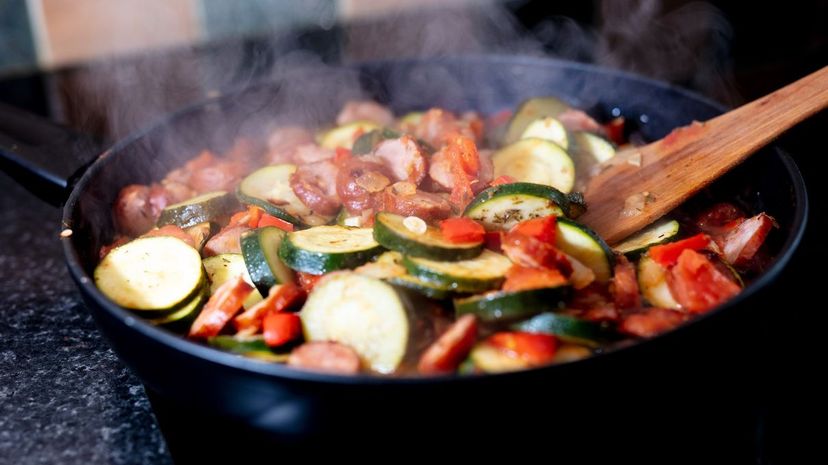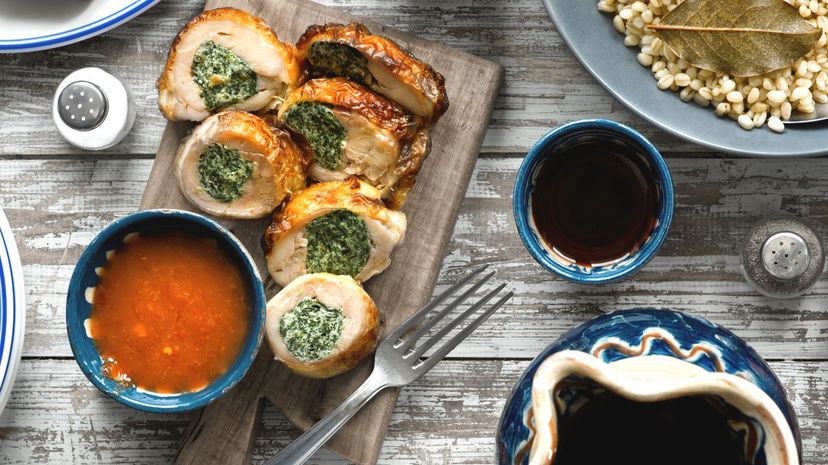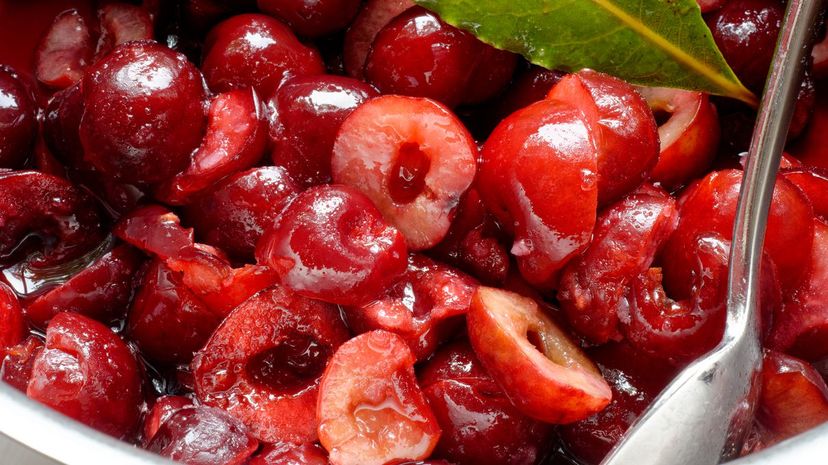
About This Quiz
Archaeological evidence suggests that humans invented cooking somewhere between 1 million and 2 million years ago. Now, odds are back then nobody was making an ooey-gooey pizza pot pie or a terribly unhealthy pulled pork poutine, and it was probably closer to a fish tossed in a fire. But cooking is cooking, and everyone has to start somewhere, right?
We've come a long way since just making a random food hot and calling it cooking was good enough. These days, you can pan fry, deep fry, broil, braise, grill, boil, parboil, sous vide, spit-roast, microwave, toast, sear, blacken, bread, poach, and confit just about anything your heart desires - or your stomach desires, for that matter. Preparing dishes involves dozens of techniques - from simple to complex - like folding, beating, whisking, stirring, mincing, chopping, bruising, dicing and about 100 other methods, depending on what you need the result to be. Now, whether you can start a fire trying to boil water or you make Gordon Ramsay look like Chef Boyardee, you have to know your cooking terms if you expect to get anything done in the kitchen. So let's take 40 of the most common cooking terms and see just how many of them you can identify.

Braise is a French term, and while most often you hear about meat being braised, it can be done to vegetables as well. The dish is often heated first by sautéing or searing it, and then it's finished in a braising liquid.

Ideally, you want your pasta to be "al dente" because it is tender and slightly firm but not hard. This is pasta that is perfectly done, as opposed to overdone - which is no longer firm - or underdone - which may still have crunch. It's Italian for "to the tooth."

Food served a la grecque is served in the Greek style, which is to say it was made with the common Greek ingredients, like lemon and olive oil, as well as specific seasonings and perhaps even vegetables common to Greek cuisine.
Advertisement

Barding is what you call it when you cover meat with a layer of fat. That may sound unappealing, but it's also the term used for when you thoroughly wrap something in bacon, which means barding is more popular than people realize.

Parboiling is a method of preparing not just rice but vegetables and other ingredients. The food is boiled until it is only partially cooked but not fully cooked. Afterwards it is usually finished in some other manner.

You would use the technique known as a chiffonade for leafy vegetables and herbs, to finely slice them into long and thin strips. Though rare, you can also use this technique with something like an omelette by rolling it up and slicing it.
Advertisement

Blanching is almost always done to vegetables, but you can also do it to fruit in some cases. It involves a very quick dip in boiling liquid that will brighten the color and lock in flavor but then putting it quickly in an ice bath to stop the cooking process.

A coulis is made from a puree of either fruits or vegetables and, as such, can be either sweet or savory. It can be used as a sauce for meats and vegetables, as an entree, or it can be a garnish as part of a dessert as well.

Caramelization occurs when sugars brown. You can add sugar to make this happen or, as with onions, allow the natural sugars to brown on their own by cooking at a low heat with oil. Anything with some amount of sugar can technically be caramelized.
Advertisement

Folding is a much more gentle mixing technique than string or beating and is used when you want to combine without stirring or changing the consistency. For instance, if you want to fold flavoring into a whipped cream, you wouldn't want to stir or beat at the risk of overworking the whipped cream.

You emulsify two things when you mix ingredients that don't normally mix, most often something like oil and vinegar, like in salad dressing. The two substances will normally separate immediately so an emulsification forces a blend, even if it's only a temporary one.

The vein in a shrimp is actually the little creature's digestive tract, which means it's decidedly unclean and undesirable. All shrimp and prawns should be deveined before cooking and serving.
Advertisement

Effiler is a very French term that refers to a specific preparation for beans. The tips are to be snapped off with your fingers and that long, string-like thread that can get stuck in your teeth is pulled away.

Flambé in most people's minds means fire, and that is essential to how it works. Most flambé happens in the pan when alcohol is added and then ignited to burn the alcohol off and leave the flavor. It can also be done table side to something like a dessert.

Kneading dough is a much more scientific process than some people realize as the process of pushing and pulling the dough causes two proteins called glutenin and gliadin to form gluten which is essential for the texture in most breads.
Advertisement

Concasse refers to a very rough chop of something that has been peeled and seeded, often a tomato. The tomato you'll find in a bruschetta is a type of concasse tomato. It can be a small or large chop, depending on your needs.

Typically meat is what you would marinate, but the process works with some vegetables as well. It involves letting the meat soak in a favored liquid for an extended period of time so that the tissue is infused with flavor.

Most of us knowing basting from a holiday turkey. The process involves moistening the food with its own juices or maybe a marinade of some kind as it cooks. A baster will allow you to suck up the hot liquids and squirt them back over the food.
Advertisement

Julienne is a type of knife cut that results in long, thin strips of whatever you're cutting. To be done properly, the food should all be cut to the exact same thickness and length when it's done for a uniform appearance.

Poaching is very similar to boiling but the difference is temperature. Poaching requires hot water of around 160-180°F but not boiling. It's a more gentle way of cooking, which is why it's suitable for something like a poached egg.

A mince is finer and smaller than a chop or even a dice, and is essentially as small as you can get something when you use a knife. A food processor could also be used to mince ingredients. Any more extreme chopping could turn it into a paste.
Advertisement

Reducing is how sauces build flavor. It allows the sauce to cook down and concentrate, making it more flavorful by boiling off water and leaving more of whatever flavor compounds are present. It needs to be done carefully lest it reduce too far and become inedible.

People will often use the words "fry" and "sauté" interchangeably. A proper sauté requires small pieces being cooked in a small amount of oil over high heat to allow for browning. The food should be moved or tossed to allow even browning, and the pan will often be deglazed to make a sauce at the end.

Searing meat involves getting a brown crust to form at high temperature. It's not caramelization because that requires sugar, A sear in meat is the result of something called the Maillard reaction that happens when amino acids and certain natural sugars reduce in heat.
Advertisement

Once food boils, the directions will often tell you to reduce to a simmer. This is a temperature just below a boil that allows it to continue cooking more gently without risking the food getting too tough or breaking apart like it might at a constant boil.

Roulades are generally prepared in one of two ways. One is a meat-based entrée, like a thin steak wrapped around a filling, and the other is a dessert made with cake wrapped around a whipped cream or jam filling like you'd find in a Swiss roll.

Jaccarding is also called needling, and it's a process used to tenderize meat. There are generally two ways to tenderize meat. This is one of the mechanical ways as opposed to chemically, which is done with marinades.
Advertisement

Recipes that require you to macerate an ingredient need you to soften or break them with a liquid. Macerated cherries, for instance, are usually cherries that are coated in sugar or maybe left in an alcohol or other liquid to bring out more flavor.

A pinch is about as vague a measurement as you can get and comes literally from the amount of salt you can pinch between two fingers. That said, it does have a corresponding measurement which is roughly 1/16 teaspoon.

If sear means to brown, and burn means to thoroughly blacken, then char is in the middle. It's when food is almost burnt but hasn't quite gotten there yet. It shouldn't have a bitter taste to it, but there should be some dark color. This is ideal for a barbecue steak, for instance.
Advertisement

You've probably heard of duck confit, but you can confit pretty much anything. It involves cooking in oil but at a lower temperature than frying. It's a slow cooking method and should take a bit of time to do properly.

A dredge is a dry mixture used to coat something like chicken, other meats and even vegetables. Typically, you'll first dip the meat in something like milk or an egg mixture, then coat it in flour, seasoning, breadcrumbs or whatever else, to form a crust when it cooks.

Any dish, like a stew or even home made mac and cheese, will require a roux which is typically a fat, like butter, and flour. The mixture will thicken, and then when something like milk is added, it becomes the base for a creamy, thick sauce. Add cheese and it's a mac and cheese sauce.
Advertisement

You can bruise many herbs, including lemongrass, to release their natural aroma and flavor by hitting them with the blunt side of a knife. It releases oils that make a dish more aromatic and flavorful than if the herbs weren't bruised.

You acidulate a dish by adding an acid such as vinegar or lemon juice - not enough to overpower the other flavors, rather as a way to sharpen the other flavors and make them pop more than they would otherwise. It can also help tenderize meats.